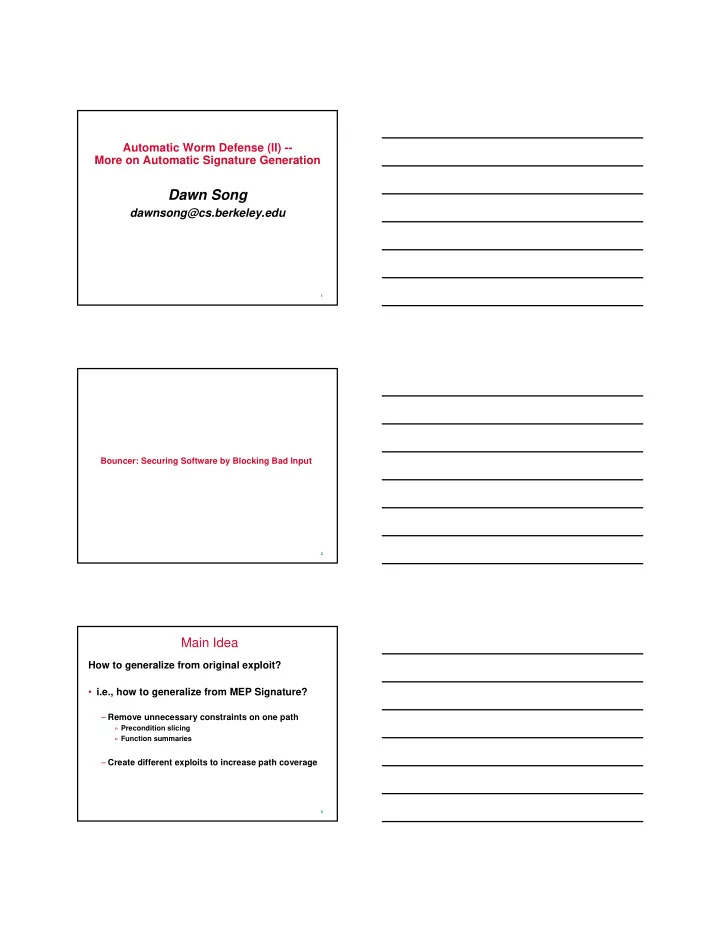

Automatic Worm Defense (II) -- More on Automatic Signature Generation Dawn Song dawnsong@cs.berkeley.edu 1 Bouncer: Securing Software by Blocking Bad Input 2 Main Idea How to generalize from original exploit? • i.e., how to generalize from MEP Signature? – Remove unnecessary constraints on one path » Precondition slicing » Function summaries – Create different exploits to increase path coverage 3
Background: Program Slicing (I) • A program slice: – The set of all statements/instructions that might affect the value of a variable occurrence • Goal: – A slice should evaluate the variable occurrence identically to the original program for all inputs • Compute slicing – Data dependency – Control dependency • Property: – Independent of input values • Applications: – Program verification, testing, etc. 4 Background: Program Slicing (II) int x=0, y=0; int *z = &y; if (msg[0] == ‘a’) x = 1; if (msg[1] == ‘b’) z = &x; *z = 0; if (x) Vulnerability = TRUE; • What’s in slice for Vulnerability? • Issues with static slicing – Conservative, too large (close to original program) 5 Background: Dynamic Slicing (I) • A narrower notion of “slice” – Consisting only statements that influence the value of a variable occurrence for specific program inputs • Applications – Debugging 6
Background: Dynamic Slicing (II) int x=0, y=0; int *z = &y; if (msg[0] == ‘a’) x = 1; if (msg[1] == ‘b’) z = &x; *z = 0; if (x) Vulnerability = TRUE; • What’s in slice for Vulnerability for msg=“ad”? • Issues with dynamic slicing for signature generation – Miss certain constraints 7 Precondition Slicing (I) • Goal – Remove unnecessary conditions without false positives • Path slice for a vulnerability point – A subset of instructions in a trace whose execution is sufficient to ensure vulnerability to be exploited – Data dependency » Easy – Control dependency » Look at all relavant paths 8 Precondition Slicing (II) • Aliasing – MayAlias (x, y) iff x and y may refer to overlapping storage locations – MustAlias (x,y) iff x and y always refer to the same storage locations for all executions – Conservative approximations • Liveness – Latest defs for operands used 9
Precondition Slicing (III) • Iterative backwards processing • When will a branch condition not be included in slice? – Postdominance relation – No path originating at the branch affects values in live – What common cases will this help? » Table lookup » Case conversion • When will a function not be included in slice? – Execution of the function does not affect values in live • Using dynamic information to improve precision – More precise dependency info on given path 10 Precondition Slicing (IV) int x=0, y=0; int *z = &y; if (msg[0] == ‘a’) x = 1; if (msg[1] == ‘b’) z = &x; *z = 0; if (x) Vulnerability = TRUE; • What’s in slice for Vulnerability for msg=“ad”? • Issues with preconditioning slicing for signature generation – Variable length fields, etc. 11 Advantages • With soundness guarantee – No false positives • Remove certain unnecessary conditions – Conditions imposed by value-dependent processing which are irrelevant to vulnerability 12
Limitations • Creating new exploits likely not work – Without data analyzer – Path exploration with mixed concrete/symbolic execution » DART/EXE type of approach » Later in class • Function summaries • Still can’t handle loops, variable length fields, etc. • May still need TM signature – Limited expressiveness 13 Compare Different Approaches for Signature Generation • Pattern-extraction based approach – W. or w/o exploit detector oracle – W. or w/o data analyzer • Program-analysis based approach – MEP signature: fairly well understood – PEP signature: How to explore different paths? » Precondition slicing, etc. – TM signature • What’s the right approach? Why? • How can we do better? – Potential project ideas » Come talk to me if interested 14 Open Mic • Other thoughts/comments? 15
Summary • Now you are an expert in automatic signature generation for worm/exploit defense :-) • Next: Botnet Analysis 16
Recommend
More recommend